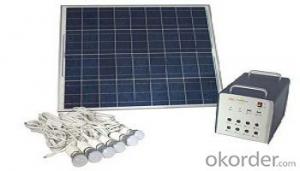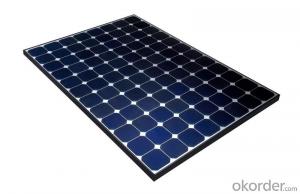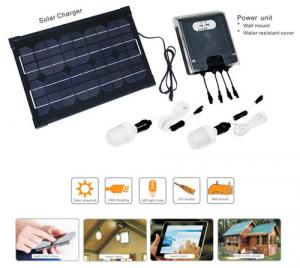Solar Energy Systems NZ - CNBM On Grid System 3000W with Certificate UL TUV CE
- Loading Port:
- Shanghai
- Payment Terms:
- TT OR LC
- Min Order Qty:
- 100 watt
- Supply Capability:
- 1000 watt/month
OKorder Service Pledge
OKorder Financial Service
You Might Also Like
Specification
CNBM On Grid System 3000W with Certificate UL TUV CE
Product description
They range from small residential and commercial rooftop systems to large utility-scale solar power stations. Unlike stand-alone power systems, a grid-connected system rarely includes an integrated battery solution, as they are still very expensive. When conditions are right, the grid-connected PV system supplies the excess power, beyond consumption by the connected load, to the utility grid.
Connection of the photovoltaic power system can be done only through an interconnection agreement between the consumer and the utility company. The agreement details the various safety standards to be followed during the connection.[4]
Systems such as Net Metering and Feed-in Tariff which are offered by some system operators, can offset a customers electricity usage costs. In some locations though, grid technologies cannot cope with distributed generation feeding into the grid, so the export of surplus electricity is not possible and that surplus is earthed.
Grid-connected PV systems are comparatively easier to install as they do not require a battery system.[1][6]
Grid interconnection of photovoltaic (PV) power generation systems has the advantage of effective utilization of generated power because there are no storage losses involved.[7]

Application
Industrial
Commercial
Residential
Feature
Residential, grid-connected rooftop systems which have a capacity more than 10 kilowatts can meet the load of most consumers.[2] They can feed excess power to the grid where it is consumed by other users. The feedback is done through a meter to monitor power transferred. Photovoltaic wattage may be less than average consumption, in which case the consumer will continue to purchase grid energy, but a lesser amount than previously. If photovoltaic wattage substantially exceeds average consumption, the energy produced by the panels will be much in excess of the demand. In this case, the excess power can yield revenue by selling it to the grid. Depending on their agreement with their local grid energy company, the consumer only needs to pay the cost of electricity consumed less the value of electricity generated. This will be a negative number if more electricity is generated than consumed.[3] Additionally, in some cases, cash incentives are paid from the grid operator to the consumer.
Packaging
With carton and box
- Q: How do solar energy systems impact energy independence in rural areas?
- Solar energy systems have a significant positive impact on energy independence in rural areas. By harnessing the power of the sun, these systems provide a reliable and sustainable source of electricity that is independent of the traditional power grid. This reduces dependence on fossil fuels and centralized energy distribution, allowing rural communities to generate their own clean energy. Solar energy systems enable rural areas to become self-sufficient and less vulnerable to power outages, price fluctuations, and supply disruptions, thus promoting energy independence and resilience.
- Q: Can solar energy systems be used in disaster-prone areas?
- Certainly, solar energy systems have the potential to be utilized in areas prone to disasters. In reality, they can prove particularly advantageous in such regions. Conventional power grids often prove to be fragile and susceptible to damage during natural calamities such as hurricanes, earthquakes, or floods. Consequently, these events can result in prolonged periods without electricity, hindering relief and recovery efforts. On the other hand, solar energy systems are decentralized and can operate independently from the grid. These systems consist of solar panels that convert sunlight into electricity, which can then be stored in batteries for use during power outages. This enables critical facilities, including hospitals, emergency response centers, and shelters, to function even when the grid is not operational. Solar energy systems can provide a reliable source of power for lighting, communication, refrigeration, and medical equipment, significantly enhancing the resilience and efficacy of disaster response. Moreover, solar energy systems can also be employed to power water pumps, ensuring that communities have access to clean water during crises. This is particularly crucial in disaster-prone areas where access to safe drinking water can be severely compromised. Solar-powered pumps can extract water from wells, rivers, or other sources, ensuring a consistent supply for drinking, sanitation, and hygiene purposes. Additionally, solar energy systems can contribute to long-term recovery efforts in disaster-prone areas. By reducing reliance on fossil fuels and conventional power grids, they can aid in the creation of sustainable and resilient communities. Solar panels can be installed on rooftops or in open spaces, utilizing the abundance of sunlight resources. This not only reduces greenhouse gas emissions and mitigates climate change but also provides a dependable and cost-effective source of energy for homes, businesses, and public infrastructure. In conclusion, solar energy systems can effectively serve disaster-prone areas by providing dependable power, supporting critical services, and promoting long-term resilience. By harnessing the power of the sun, these systems offer a sustainable and decentralized solution to energy needs, ensuring that communities can withstand and recover from natural disasters more effectively.
- Q: Can solar energy systems be used for powering remote sensing or surveillance equipment?
- Yes, solar energy systems can be used for powering remote sensing or surveillance equipment. Solar panels can be installed to capture sunlight and convert it into electricity, which can then be used to power the equipment. This is particularly useful in remote locations where access to traditional power sources may be limited or unavailable. Additionally, solar energy systems are often considered more sustainable and cost-effective in the long run compared to using fossil fuels or relying on batteries for power.
- Q: How can I find a reputable solar energy system installer?
- To locate a trustworthy installer for your solar energy system, you can follow these steps: 1. Educate yourself and conduct research: Begin by familiarizing yourself with solar energy systems, their functioning, and the various installation options. This will enable you to grasp the fundamentals and make well-informed decisions during the selection process. 2. Seek recommendations: Reach out to friends, family, colleagues, or neighbors who have already installed solar systems. Inquire about their experiences with the installers they hired, the quality of their work, and any challenges they encountered. Recommendations from reliable sources can be valuable in finding reputable installers. 3. Verify credentials and certifications: Ensure that the installer you are considering possesses the necessary licenses, certifications, and insurance to carry out solar installations. Look for certifications from esteemed organizations like the North American Board of Certified Energy Practitioners (NABCEP) or the Solar Energy Industries Association (SEIA). 4. Explore online reviews and ratings: Delve into online review platforms such as Google, Yelp, or Angie's List to read customer reviews and ratings about various solar installers in your vicinity. Pay attention to recurring positive or negative feedback and consider the overall reputation of the installers. 5. Obtain multiple quotes: Reach out to several solar installers and request detailed quotes for your specific project. Take note of the proposed equipment, warranties, pricing, and any additional services included. This will enable you to compare different installers and make an informed decision. 6. Request references and review past projects: Ask the installer for references to speak with previous customers about their experiences. Inquire about the quality of work, timeliness, customer service, and any issues encountered. Additionally, request examples of past projects completed by the installer to assess their workmanship and attention to detail. 7. Evaluate warranties and after-installation services: Inquire about the warranties provided by the installer for both the equipment and the installation work. A reputable installer will offer comprehensive warranties to ensure the longevity and performance of your solar system. Additionally, ask about any after-installation services they provide, such as maintenance, repairs, or monitoring. 8. Seek multiple opinions: If you have any doubts or concerns during the selection process, do not hesitate to seek a second opinion from another reputable installer. This can help you gain further clarity and confidence in your decision. Remember, finding a reputable solar energy system installer is vital for the long-term success and performance of your solar system. Take your time, conduct thorough research, and select an installer that aligns with your needs, budget, and values.
- Q: How do solar energy systems impact renewable energy targets?
- Solar energy systems have a significant impact on renewable energy targets as they contribute to increasing the overall share of renewable energy in the energy mix. By harnessing the power of the sun, solar systems generate clean electricity, reducing the reliance on fossil fuels. This helps countries and communities to meet their renewable energy targets by diversifying their energy sources and reducing greenhouse gas emissions. Additionally, the scalability and accessibility of solar technology make it a viable option for both large-scale projects and individual homeowners, further accelerating the progress towards renewable energy targets.
- Q: What are the disadvantages of using solar energy systems?
- While solar energy systems offer numerous benefits, they do have a few disadvantages. One major drawback is their dependency on sunlight, meaning they generate less electricity during cloudy or nighttime conditions. Additionally, the initial installation cost can be quite high, although it is typically offset by long-term savings. Solar panels also require a significant amount of space for installation, which may not be feasible for everyone. Lastly, the manufacturing process of solar panels can have environmental impacts, including the use of certain materials and chemicals. However, ongoing advancements in technology are addressing these concerns and making solar energy an increasingly viable and sustainable option.
- Q: Can solar energy systems be used for powering electric bus charging stations?
- Yes, solar energy systems can be used to power electric bus charging stations. Solar panels can generate electricity from sunlight, which can be used to charge the batteries of electric buses. This renewable energy source allows for a sustainable and eco-friendly way to power the charging infrastructure for electric buses.
- Q: Can solar energy systems power an entire home or business?
- Yes, solar energy systems have the potential to power an entire home or business. The size and efficiency of the system, as well as the energy requirements of the property, play a crucial role in determining if it can meet all the energy needs. With the right design and installation, solar energy systems can provide enough electricity for the entire building, while also reducing reliance on traditional energy sources and lowering carbon emissions.
- Q: Can solar energy systems be installed in urban areas?
- Yes, solar energy systems can be installed in urban areas. In fact, urban areas have a great potential for solar energy due to the availability of rooftops, parking lots, and other open spaces. Solar panels can be integrated into buildings and infrastructure, providing clean and renewable energy to power homes, businesses, and even entire neighborhoods. Additionally, advancements in technology have made solar panels more efficient and aesthetically pleasing, making them suitable for urban environments.
- Q: How much do solar energy systems cost?
- The cost of solar energy systems varies depending on several factors such as the size of the system, the location, and the specific components used. On average, a residential solar system can range from $15,000 to $25,000 after accounting for federal tax incentives and other rebates. However, it's important to note that prices have been declining rapidly in recent years, making solar energy more affordable and cost-effective in the long run.
Send your message to us
Solar Energy Systems NZ - CNBM On Grid System 3000W with Certificate UL TUV CE
- Loading Port:
- Shanghai
- Payment Terms:
- TT OR LC
- Min Order Qty:
- 100 watt
- Supply Capability:
- 1000 watt/month
OKorder Service Pledge
OKorder Financial Service
Similar products
Hot products
Hot Searches
Related keywords


























